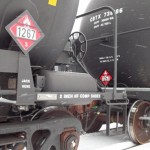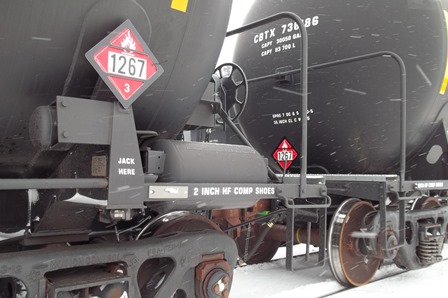Recent derailments and resulting fires indicate that the type of crude oil being transported from the Bakken region may be more flammable than traditional heavy crude oil | |
The above determination was made by the USDOT Pipeline and Hazardous Materials Safety Administration (USDOT/PHMSA) based on preliminary inspections conducted after recent train derailments in North Dakota, Alabama, and Lac-Mégantic, Quebec; each of which involved Bakken crude oil.

As part of its investigations, the PHMSA and the Federal Railroad Administration (FRA) have initiated Operation Classiification. this compliance initiative includes unannounced inspections and testing of samples collected from Bakken crude oil being offered for transportation. The purpose of the testing is to ensure the Shipper of the crude oil has properly classified the HazMat.
The proper classification of a hazardous material requires the identification of all of its potential hazards and the determination of its relative degree of danger (high, medium, or minor) which is indicated by the packing group (I, II, & III, respectively).
Classification of Bakken crude oil:
The hazard class indicating its potential hazard(s) is Class 3 – Flammable and Combustible Liquid as defined at 49 CFR 173.120 since it has the ability to ignite and burn under the proper conditions. There are several criteria for defining a Class 3, but the critical one for the Bakken crude oil is this,
…a flammable liquid (Class 3) means a liquid having a flash point of not more than 60 °C (140 °F)…
The criteria for determining the packing group for a flammable liquid is defined at §173.121 and is based on the relationship of the flammable liquid’s flash point to its initial boiling point as indicated in Table 1:
Table 1
Packing group | Flash point (closed-cup) | Initial boiling point |
| I | ≤35 °C (95 °F) | |
| II | <23 °C (73 °F) | >35 °C (95 °F) |
| III | ≥23 °C, ≤60 °C (≥73 °F, ≤140 °F) | >35 °C (95 °F) |
While the determination of the Bakken crude oil’s hazard class (Class 3 Flammable and Combustible Liquid) is not in doubt, the correct identification of its packing has proved to be a challenge. The determination of the packing group is further complicated by the possibility, it is believed, of chemical changes to the oil once it is in transportation and after the classification has been made by the Shipper. For example, it is possible that a shipment of Bakken crude oil classified as a Class 3 packing group II may become a Class 3 packing group I while in transportation. Why is that a problem? Because, as anyone who has attended my HazMat Employee training knows, the correct classification of a hazardous material is essential for its safe transportation in commerce, since it is the classification of a hazardous material (its hazard class, packing group, proper shipping name, and identification number) that determines –
- The authorized packaging.
- The applicable Special Provisions of column 7 of the Hazardous Materials Table.
- If the HazMat is forbidden for transportation.
- If exceptions from regulation are available.
- The hazard communication methods required: shipping papers, placards, labels, & markings.
- If HazMat Incident Reporting is necessary.
- If Shipper or Carrier registration is required.
- The applicable HazMat Security requirements.
The importance of the Hazardous Materials Classification and its likely errors in the situation of the Bakken crude oil is the reason the PHMSA and the FRA are conducting additional testing of the HazMat in question and requiring shippers to do the same.
Anyone involved in the transportation of a hazardous material – like the Bakken crude oil – must receive initial (within 90 days of new hire) and triennial (every three years thereafter) HazMat Employee Training per the regulations of the PHMSA at 49 CFR 172, Subpart H. Contact me for the HazMat Employee training that you need.
Daniels Training Services 815.821.1550/Info@DanielsTraining.com/https://danielstraining.com/ |
Read the PHMSA Safety Alert from January 2, 2014 – Preliminary Guidance from Operation Classification

